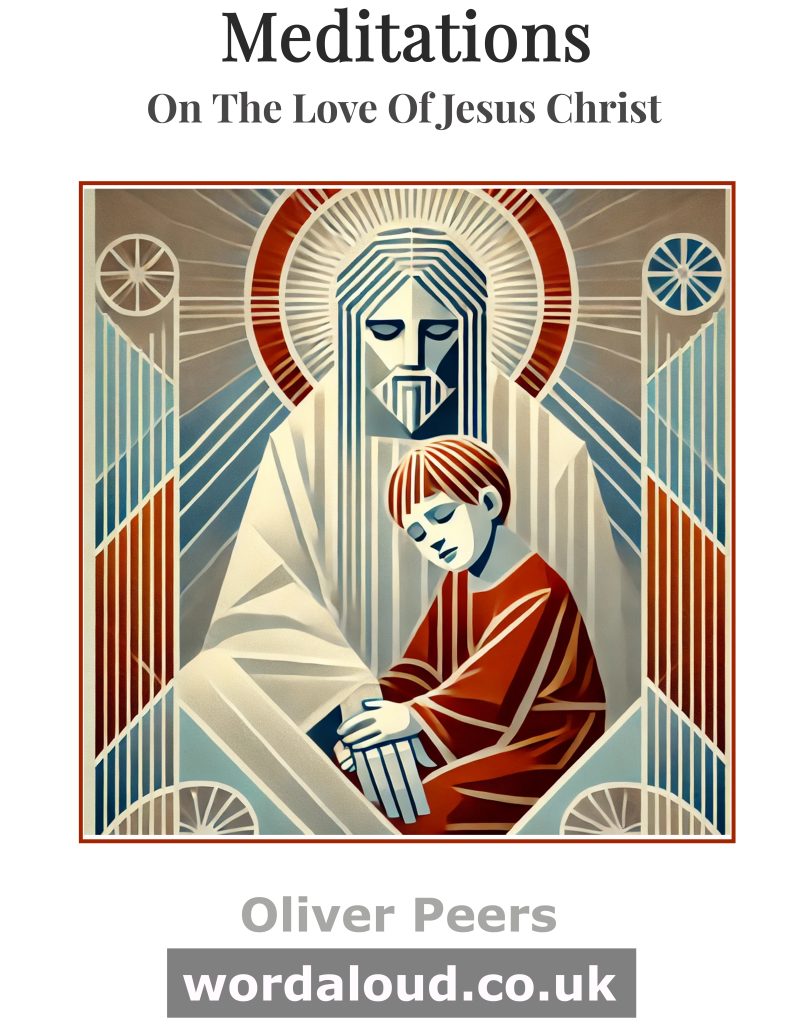Christian Art | Lent | Daily Verses
Matthew 5: 43-48 – Lent Week 1, Saturday; also Tuesday Week 12 (King James Audio Bible KJV)
43 ¶ Ye have heard that it hath been said, Thou shalt love thy neighbour, and hate thine enemy.
44 But I say unto you, Love your enemies, bless them that curse you, do good to them that hate you, and pray for them which despitefully use you, and persecute you;
45 That ye may be the children of your Father which is in heaven: for he maketh his sun to rise on the evil and on the good, and sendeth rain on the just and on the unjust.
46 For if ye love them which love you, what reward have ye? do not even the publicans the same?
47 And if ye salute your brethren only, what do ye more than others? do not even the publicans so?
48 Be ye therefore perfect, even as your Father which is in heaven is perfect.
The Sermon on the Mount continues with Christ’s call to reconciliation and forgiveness. Jesus urgently wishes the Jews to be at peace among themselves, and he implores his listeners not to aggravate the Roman oppressors, whose utter brutality in suppressing dissent would indeed ultimately destroy Jerusalem. (We should remember that, prior to AD 70, thousands of Jews could be crucified at just one go to suppress insurrectionary threats.) Just as God’s love is for everyone, so we should see everyone as being our neighbour. This is the truth of the teaching of Levitus (19:18): ‘You shall love your neighbour.’
Matthew particularly includes this saying of Jesus because, at the time when he is writing, as in the time of Jesus, there was much competition between rival factions, including among the Jews. The destruction of the Temple, and the slaughter in Jerusalem, in AD 70 would not have helped this situation: this plunged the Jewish people into greater confusion; enemies must have been sensed on every side. Matthew’s Gospel is, then, both a call to brotherly unity and a call to love and to seek to understand all mankind. Especially when people of different faiths and cultures live proximately, and thereby, as we see in the 21st Century, when tensions can be most liable to arise, there is a need to see all people as our neighbours.
These Bible verses develop on the themes of yesterday’s reading. We must reach out with love for all. We think of Jesus tortured and crucified. Despite the agonizing pain and the humiliation, being whipped, spat at, mocked with a crown of thorns, forced to carry his cross through the streets and the jeering crowds, stripped and nailed to the cross to die, Jesus’ thought is to petition his Father to forgive those who are torturing him to death, and to find an excuse for them: ‘Father, forgive them, they know not what they do.’ Jesus loved the people who are killing him. The poison of hatred did not succeed in polluting Christ’s love for us all. ‘Love your enemies.’
It is entirely just, therefore, that we are commanded to be perfect. Strictly speaking, this is impossible: God alone is perfect. We are taught, though, to model ourselves on the perfection of God, while we realise our human flaws and the infinite distance between ourselves and God. We pray for the considerable help grace can give to us as we seek to move toward divine perfection. We should think as well of which particular forms of perfection we are called to imitate. The context suggests that Jesus is thinking of God’s love and mercy. This is a universal call to holiness, to all the brotherhood of man. Christ commands everyone, without exception, to be thus perfect.
‘He was oppressed, and he was afflicted, yet he opened not his mouth: he is brought as a lamb to the slaughter, and as a sheep before her shearers is dumb, so he openeth not his mouth.’

![]()
King James Audio Bible | Endnotes
How Does Jesus Teach That God Is Love?
The events of the Garden of Gethsemane and the Crucifixion of Jesus, Jesus on the Cross, offer powerful reflections on the idea that ‘God is love’.
In the Garden of Gethsemane, Jesus faced the agony of knowing that he was about to undergo the worst possible suffering and death. As he prayed to God for strength and courage, he showed his complete trust in the love of God. Jesus knew that his sacrifice would be the ultimate act of love, and he was willing to endure the pain and suffering because he believed in God’s love for humanity.
At the crucifixion, Jesus’ love for humanity was once again demonstrated. As the Apostle John wrote: ‘For God so loved the world, that he gave his only begotten Son, that whosoever believeth in him should not perish, but have everlasting life.’ (John 3:16 KJV) Through his death, Jesus showed that God’s love is not limited by our human understanding. He bore the punishment for our sins so that we could be reconciled to God and experience his love and forgiveness.
The image of Jesus on the Cross has become a sign of God’s love for humanity throughout Christian history. The Cross declares that God is love, that God’s love is unconditional and sacrificial. It shows that God is willing to go to any lengths to demonstrate his love for us, even to the point of allowing his own Son to die.
The Gospel of Saint John opens with a powerful statement about the nature of God’s love: ‘In the beginning was the Word, and the Word was with God, and the Word was God.’ (John 1:1 KJV) This statement points to the idea that Jesus, who is often referred to as ‘the Word’. is a manifestation of God’s love for humanity. The Gospel goes on to describe Jesus as the light of the world, the way, the truth, and the life (John 8:12, 14:6).
Jesus’ death on the Cross is not simply an historical event, but a demonstration of God’s enduring love for all people. As the Apostle Paul wrote: ‘But God commendeth his love toward us, in that, while we were yet sinners, Christ died for us.’ (Romans 5:8 KJV) Through his death and resurrection, Jesus has provided a way for us to experience God’s love and forgiveness, and to live in hope of eternal life.
In conclusion, the Garden of Gethsemane and the crucifixion of Jesus on the cross offer powerful reflections on the thought that ‘God is love’. Jesus’ willingness to endure suffering and death shows his complete trust in God’s love, and his sacrifice on the Cross demonstrates the extent of God’s love for all people. Through his death and Resurrection, Jesus has provided a way for us to experience God’s love and forgiveness, and to live in hope of eternal life.








